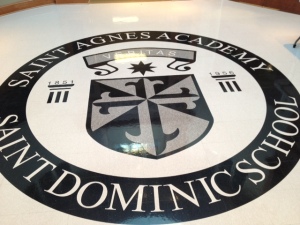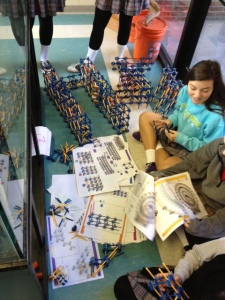 St. Agnes Academy and St. Dominic School is the oldest continuously operating school in Memphis, according to 19-year President Barbara Daush. They have 915 students; boys are preK-8 and girls preK-12. When I arrived at the stunning new Veritas Research Center building, a group of girls were headed off for a morning of service at a downtown soup kitchen. Barbara took me through a central atrium where the four pillars of their school were prominently displayed: study, community, prayer, and service. Then I was pleasantly surprised to be greeted by a group of about 25 faculty, staff, trustees, and parents who shared for an hour their thoughts about innovation: what it means, what is taking place at the school, how learning is changing, and how the school is changing to meet the challenges of a rapidly changing world. It was a fired-up group of passionate educators and committed parents, and their own words are better than my summary.
St. Agnes Academy and St. Dominic School is the oldest continuously operating school in Memphis, according to 19-year President Barbara Daush. They have 915 students; boys are preK-8 and girls preK-12. When I arrived at the stunning new Veritas Research Center building, a group of girls were headed off for a morning of service at a downtown soup kitchen. Barbara took me through a central atrium where the four pillars of their school were prominently displayed: study, community, prayer, and service. Then I was pleasantly surprised to be greeted by a group of about 25 faculty, staff, trustees, and parents who shared for an hour their thoughts about innovation: what it means, what is taking place at the school, how learning is changing, and how the school is changing to meet the challenges of a rapidly changing world. It was a fired-up group of passionate educators and committed parents, and their own words are better than my summary.
How is learning changing?
- “We are pretty much on the same level as the students now. It used to be we were supposed to know everything; now we are asking them to identify and solve the problems. We are coaching them along.”
- “Our job is to get them comfortable with challenging assumptions.”
- “Students want to leap straight to an answer and then go on; we have to get them comfortable with ambiguity.”
- “Our students are much more in tune with a global perspective and issues. They are willing to look farther afield, for college, for example.”
- “We need to start that creative process of learning to take risks at a very young age.”
- “Teachers need to grow to be able to see how to gain access to knowledge in unconventional ways.”
- “Teachers are now helping students learn how to learn.”
- “More noise; it is the sound of collaboration.”
- “Our generation was the one of overhead projectors and little black pens. We thought of noise as play. Noise is collaborative learning.”
- “Students are buying into the changes quicker than the parents. The discussion of grades with students is increasingly giving way to a discussion of what they have learned.”
- “I start the school day with a plan and often the students head me off in another direction. I have to be able to go with them, to a point.”
- “I need to validate the students’ voice.”
How is the school changing?
 “Good leadership. Barbara sets a clear vision and then it is pretty much up to us to get on the bus.”
“Good leadership. Barbara sets a clear vision and then it is pretty much up to us to get on the bus.”- “Barbara allows us each to be professional and find our own way.”
- “Change is more comfortable and better if it is a series of frequent steps, a continuous process, going back and checking often against the vision to make sure you are on the right path.”
- “You have to allocate time for essential collaboration.”
- “Everyone has to get in tune with the vision, but it is also agreed upon that there are lots of ways to express the vision. There are many of things to do on the boat, but you have to be on the boat.”
- “You have to let go of your ego.”
From the trustees:
- “We trust our leaders.”
- “We want our leaders to push us, beg and plead with us, but at the end, we are going to support their vision.”
- “These innovations in education will take marginal students and make good students of them.”
After this great give-and-take, I toured the campus. Here are a few highlights we uncovered by poking into classrooms and offices:
- The senior lounge has an idea wall for the students to write on.
- Three students had fake babies in carriers. These are high tech fake babies that are programmed to cry, need food, and other care. The girls wear monitors for 24 hours that a teacher can download. Each girl is expected to “care” for the baby for an entire day to gain the experience of what a baby requires. Is there a better life skills exercise than this for both gender students?
- Each student begins to compile a personal portfolio in 9th grade that includes a personal philosophy statement, resume, letters from teachers, and lists of activities and achievements. The binder is available to counselors at any time and contains the compilation of materials the college counselors need for seniors.
- The new wing for early childhood was designed with a lot of input from the teachers. The windows are about two feet off the ground…right where short people need them to be!
The four-year old Distance Learning Center has become a real hub of learning. It is used every day by different classes to connect with both paid vendors who provide some non-traditional lessons, and a variety of free distance learning exposures. When we stopped in the 3rd grade was learning geometry through a three-dimensional thinking exercise. They have connected with students in several other states, reading the same books, discussing with students from a variety of backgrounds. They link with sources in museums, on research expeditions, and at universities. The high school Justice class connected via the U.S. Constitution Center with 14 other schools to hold conversations on health care and immigration law. 7th graders participated in a program of student-created content, building a 45-minute presentation in conjunction with the Memphis Zoo that included video, interviews, and a game show element, and then taught the class to other younger students around the country. The Center is also a way to leverage professional development resources as faculty can be linked in for PD without having to travel.

President Daush INSISTED I take and post this photo of “the cutest toilet seat in any early childhood school”!
I met with Dr. Mary Marable, who has completed her PhD in Educational Leadership and has a new set of responsibilities this year, but she and Barbara have not really figured out her title yet. It will be “something like Director of Coaching and Mentoring of Teachers”, and once again…do you have a title like that at your school? Why the ambiguity of title? “It is appropriate, because we don’t really know what the end is going to be. We know we have to continue to grow as learners. We have to evolve to meet the students where they are, and that is a constantly moving target in ways that it was not in the past.” Mary is working with a faculty team to bring new forms of PD to the teachers and to coordinate a more authentic faculty assessment tool that is focused on this continuous growth model than on classroom observation and evaluation.
Once again I had the chance to sit and talk with students about how they see learning changing and what excites them about their learning. And once again it was nice to see that what excites the students is also leading where our best teachers are going. Some of their comments:
- “Learning is becoming more personal and more interactive. Everyone needs to be able to add to the discussion.”
- “Technology helps us do more work for ourselves.”
- “Larger, more complicated group projects are more available to us because of technology.”
- “I want talking and discussion; I get excited by that interaction.”
- “The good classes are those where you understand the purpose. Some classes seem that they are just required and you don’t see the relevance.”
- “I don’t like busy work, packets, worksheets of filling in the blanks, moving information from one place to another.”
“I want to think, to put things together. The process of learning is more engaging than getting an answer.” - “Give us a good foundation, but then we want to progress on our own.”
The faculty leaders, administration, trustees, and students all seem to be reading from the same playbook!






Thank you for taking the time to visit SAA/SDS. Your feedback is important to the St. Agnes community and will be helpful as they continue to create a learning community that embraces continuity and change.